Our Lakes, Our Lives: A tribute to the great lakes of Texas
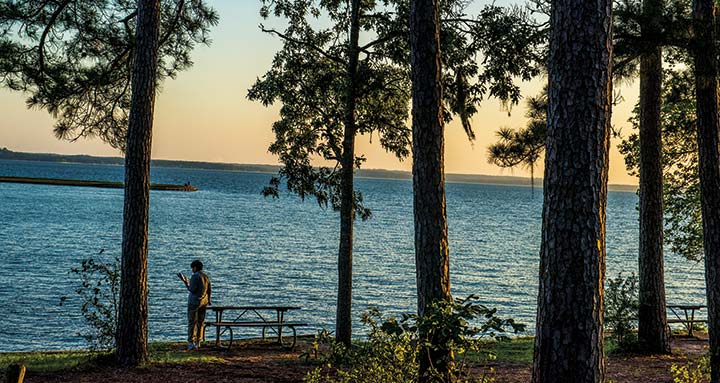 in Polk County, and Wolf Creek Park near the town of Coldspring, run by the Trinity River Authority. Established in 1977, the state park is extremely popular with travelers from Dallas and Houston especially. Surprisingly, it also sees its share of international tourists hoping to add birds to their life lists. Interpretive ranger Joel Janssen says specialties include indigo buntings and redheaded woodpeckers.
in Polk County, and Wolf Creek Park near the town of Coldspring, run by the Trinity River Authority. Established in 1977, the state park is extremely popular with travelers from Dallas and Houston especially. Surprisingly, it also sees its share of international tourists hoping to add birds to their life lists. Interpretive ranger Joel Janssen says specialties include indigo buntings and redheaded woodpeckers.
The park store has been renovated and expanded, lakeside hiking trails have been upgraded, and more picnic tables and barbecue grills have been added to the day-use areas. Looking ahead, plans are on tap for an interactive nature center and updates to campgrounds and other facilities.
Wolf Creek, a pleasant seasonal facility on the west side of the lake, opens from March through November and offers a swimming area, playground, boat ramps, and a marina and grocery. With the lake’s 450-plus miles of shoreline, be sure to leave enough time to explore.
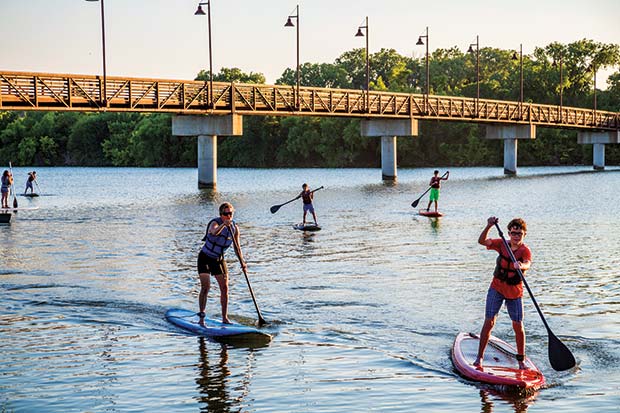 is to Dallas as Frederick Law Olmsted’s famous Central Park is to New York City—a place where locals love to get away, but so iconic that visitors come from across the land to explore and play. The historic 1,100-acre lake was born in 1911, when city leaders dammed White Rock Creek to create a new source of drinking water. After some years of neglect, in 1995 the lake got a new lease on life when Dallas voters approved a $9-million bond for its restoration.
is to Dallas as Frederick Law Olmsted’s famous Central Park is to New York City—a place where locals love to get away, but so iconic that visitors come from across the land to explore and play. The historic 1,100-acre lake was born in 1911, when city leaders dammed White Rock Creek to create a new source of drinking water. After some years of neglect, in 1995 the lake got a new lease on life when Dallas voters approved a $9-million bond for its restoration.
Today, White Rock Lake has many fans. It has emerged an epicenter for family fun, fitness devotees, and nature lovers alike. “We are one of the largest urban lakes in the country,” says Jennifer Hoesterey of the non-profit White Rock Lake Conservancy, which fundraises on behalf of Dallas Parks and Recreation and sponsors events such as the spring Celebration! White Rock (usually in April)—featuring food trucks and fun runs. “People come from all over to see what we have to offer.”
Hoesterey estimates the lake sees 2 million visitors each year. Tourists and locals come to investigate a wide array of amenities, such as the Audubon-designed birding area, or to hike through the park’s patches of wildlife-rich urban wilderness. A nearly 10-mile hike-and-bike circuit rings the lake as well. There is sailing and paddling and some fishing, but no swimming. Instead, rent a canoe, kayak, or stand-up paddle board at the White Rock Paddle Co.
Recent park projects, like new lighting, a new dog park, and renovations to a CCC pavilion, are almost completed. Several hills, including Flagpole Hill—popular on those rare occasions when snowfall makes sledding possible—draw picnickers in nice weather, but there’s plenty of fun year-round.
3. Somerville Lake: Fun and Sun
Grab a burger at Grump’s Bar & Grill, at Big Creek Resort Marina and Campground in Lyons.
In the rolling hills near Brenham, the waters of Somerville Lake have long been a beacon to nature-lovers from Houston, Austin, and College Station, who have discovered the charms of this 11,630-acre reservoir born in the 1960s as a flood-control project. With 85 miles of shoreline, Somerville’s current recreational options are numerous, with Texas Parks and Wildlife, the U.S. Army Corps of Engineers, and private marinas offering a fun variety on and off the water.
There are 11 boat ramps around the lake, maintained by various entities. Along with a pair of state park units—Nails Creek and Birch Creek, connected by the 13-mile Lake Somerville Trailway, open to horses, hikers, and mountain bikers (part of a larger system of trails that extends more than 37 miles)—there are three Army Corps parks at Rocky Creek, Yegua Creek, and Overlook Park. These parks all offer camping year-round and easy lake access for anglers and boaters of all stripes. In addition, a pair of lakeside marinas offers accommodations, Lake Somerville Marina and Campground and Big Creek Resort Marina and Campground. Both rent jet skis for folks who want to supercharge their stay with aquatic motorsports.
Both marinas also have swimming beaches, RV hookups, lakeside cabins, and a variety of tent campsites. Somerville Marina has a well-stocked store with plenty of fishing supplies. For explorers looking for a backcountry adventure, the TPWD trails connecting Wolf Pond and Newman’s Bottom visit primitive campsites.
Note: At press time, the lake’s parks and facilities were closed due to flooding. Check the status at www.tpwd.texas.gov/state-parks/lake-somerville or www.swf-wc.usace.army.mil/somerville.
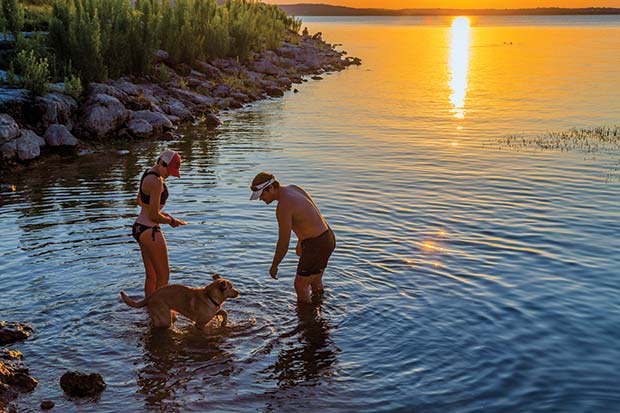 at Canyon Lake Marina.
at Canyon Lake Marina.
The wall of Canyon Dam rises 224 feet above the stream below, dividing the Guadalupe River into something like Dr. Jekyll and Mr. Hyde. Below the dam, anglers cast for rainbow trout (stocked during the winter), and tubers float in the cool, swift current on hot summer days. Above the dam, however, the flat surface of this favorite Hill Country destination is like another world, dominated by an 8,000-acre lake that’s bordered by forested ridges.
Since its creation in 1964, Canyon Lake has been a popular retreat for residents of San Antonio and Austin, whether finding haven at lake houses or campgrounds. The U.S. Army Corps of Engineers manages Canyon Lake with the Guadalupe-Blanco River Authority and operates eight parks, including four with camping and two with group shelters, as well as beaches and boat ramps. There are lighted fishing piers on both sides of the lake, and Canyon Lake Marina rents ski boats, pontoon boats, kayaks, and wave runners. Canyon Lake also has an active sailing scene, with seasonal races, regattas, and a variety of courses for those new to the sport; the Lake Canyon Yacht Club and Hill Country Yacht Club can get you started.
Built to protect downstream communities from disastrous floods, Canyon Dam was put to the test in 2002 when three feet of rain in one week forced water over the emergency spillway for the first time since the dam was built. The flow of water and debris carved through the 110-million-year-old Glen Rose limestone, creating what is now known as Canyon Lake Gorge. The Gorge Preservation Society (www.canyon gorge.org) offers regular three-hour educational tours of the scoured spillway with stops to view dinosaur tracks, spring-fed pools, waterfalls, and all manner of rock formations, from ancient aquatic channels to the Balcones Fault, geodes, and the fossils of ancient sea organisms like bivalves and gastropods.
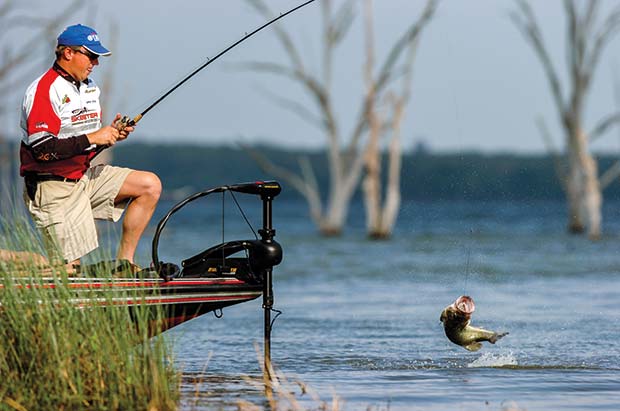 , which boasts a camp-record lunker weighing 10.18 pounds. That might not be enough to land you in the record books, but a trip to Lake Fork could provide the catch of a lifetime.
, which boasts a camp-record lunker weighing 10.18 pounds. That might not be enough to land you in the record books, but a trip to Lake Fork could provide the catch of a lifetime.
Tiffany’s Restaurant at Lake Fork Marina in Alba (903/ 765-2087) specializes in steaks and housemade pies.
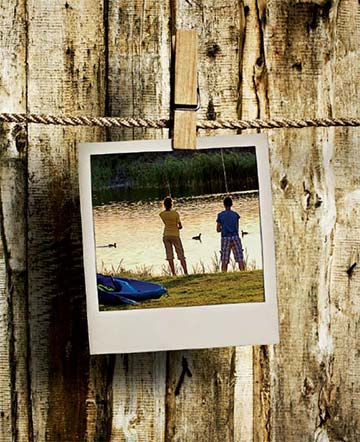 on Texas 72 between Choke Canyon State Park and Three Rivers.
on Texas 72 between Choke Canyon State Park and Three Rivers.
An oasis among the rolling brush country of the South Texas Plains, Choke Canyon Reservoir and the Frio River Valley have been drawing visitors for nearly 13,000 years. Archeological evidence collected along the Frio River, dammed in the 1980s to secure drinking water for Corpus Christi, indicates that hunter-gatherers likely crossed the region in pursuit of bison and perhaps mammoth. These days, though the lake has dropped significantly due to drought, its shores still draw visitors for fishing, spotting wildlife, and reflecting on the subtle beauty of the surrounding thickets of mesquite and blackbush acacia.
Most of the reservoir action takes place at the Calliham Unit of Choke Canyon State Park, located 12 miles west of Three Rivers (named for the nearby junctions of the Frio with the Atascosa and the Nueces). The 1,100-acre park has a swimming area, volleyball court, and softball diamond, as well as screened shelters and a mix of walk-in and drive-up campsites. The state park’s South Shore Unit is open only for day use; at press time, the south shore boat ramps were closed.
The lake, 40-square-miles when full, has produced truly impressive black bass, with the record pegged at 15.45 pounds, several smallmouth buffalo in the 40- to 50-pound range, and the second-largest alligator ever recorded in the state—a 14-foot, 3-inch bull gator weighing 800 pounds taken in 2013 in the James E. Daughtrey Wildlife Management Area, along the reservoir’s upper reaches.
While not everyone may appreciate Choke Canyon’s claim as the westernmost common occurrence of the American Alligator, it’s worth noting that the American Birding Association has identified the reservoir as important bird habitat. The area is the northernmost range for several Mexican species, as well as home to the crested caracara and Rio Grande turkey. Even so, a life list is not necessary to celebrate this special place.
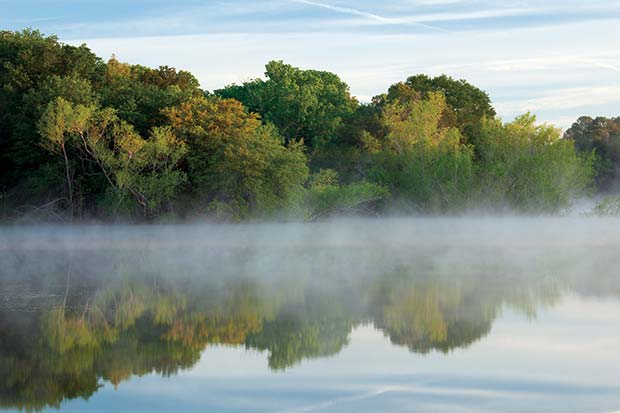 in Smithville, less than five minutes from Buescher State Park.
in Smithville, less than five minutes from Buescher State Park.
The value of certain gems comes from their purity, rather than their size. Such is the case of 20-acre Buescher Lake, hidden within the Lost Pines region a mere 45 miles east of Austin. As the centerpiece of Buescher State Park, the pond remains a peaceful escape from the rigors of urban life, catering to canoes and kayaks (rentals available). Swimming is not allowed, but the fishing can be good for bass, catfish, crappie, perch, and rainbow trout during the winter. Eight miles of hike-and-bike trails wind through the park’s woodlands of loblolly pine and cedar elm trees.
Separated from the Piney Woods of East Texas by 100 miles, the loblolly forests of the Lost Pines have flourished in the area’s sandy soil for millennia. Devastating wildfires in 2011 spared Buescher State Park but consumed most of neighboring Bastrop State Park (five times the size of Buescher at 6,000 acres). Buescher and Bastrop state parks together cover 11 square miles of Lost Pines habitat, and they’re linked by Park Road 1C—one of the state’s most scenic stretches of pavement. Its still-mostly-shaded 13 miles provide an up-close view of the burned forest in recovery. Despite some substantial hills, it’s a cyclist-friendly stretch, which lends itself to frequent stops for wildlife watching, including 250 species of birds, deer, bobcats, and more. By visiting the area, you can help the Lost Pines recover—making sure that this little slice of paradise is around for generations to come.
8. Inks Lake: Devilishly Fun!
Fuel up and cool down with burgers and snow cones at Sweet Marley’s, Inks Lake State Park’s new food vendor (512/793-2223).
Amid the granite bluffs of Inks Lake stands its most popular feature: a heavenly swimming hole by the unlikely name of Devil’s Waterhole.
Located about 90 minutes northwest of Austin, the 800-acre Lower Colorado River Authority reservoir enjoys fairly constant levels, meaning that if you’re daring enough to make the leap off the nearby rocks, you will find plenty of water on splashdown. The waterhole lies below a small canyon that forms part of the eponymous Inks Lake State Park, and after a decent rain or during wet times of the year you can explore the waterfalls of Valley Spring Creek as well.
Fishing and boating are other popular activities on the lake, so jumpers should look before they leap. You can rent a canoe, paddleboat, or kayak at the park store, or take advantage of the jutting fishing piers along the shoreline. Thanks to a large no-wake zone, Inks Lake is a great place for families and novice paddlers to work on their flat-water skills. Bass, crappie, and catfish all call these waters home.
The 1,200-acre state park also has an extremely popular campground, as well as cabins to rent, and about seven miles of hiking trails. Local wildlife includes white-tailed deer, bobcats, and birdlife such as wild turkey, osprey, bald eagle, and assorted songbirds. Additional entertainment can be found at Inks Dam National Fish Hatchery, and Longhorn Cavern State Park. Year-round, the remarkable cave stays a constant 68 degrees. Both facilities open daily.
Meanwhile, it’s just a mile-long paddle from the park beach to the heart of the Devil’s Waterhole, which also makes this a popular full-moon adventure. The park hosts canoe clinics as well, but whether you hoof it or paddle to the waterhole, it’s a spot all Texans should soak up at least once.
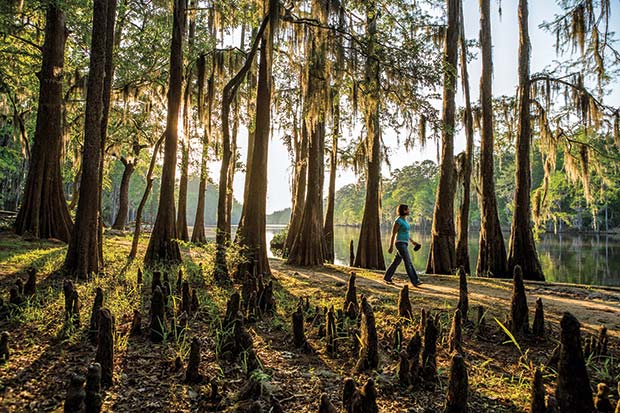 in Karnack for fried alligator and catfish.
in Karnack for fried alligator and catfish.
Most major lakes in Texas are in truth reservoirs created for power generation, flood control, or to provide drinking water to nearby towns and cities. Not so Caddo Lake, which despite minor human manipulations, is one of the state’s two naturally formed large bodies of freshwater—a crazy-quilt of bogs, oxbows, ponds, and seeps covering some 26,000 acres spanning the Texas-Louisiana boundary.
To journey into Caddo Lake’s mossy, cypress-studded primordial landscape is to travel through history. The Caddo Indians who gave their name to the site settled in the area hundreds of years ago, and attributed the formation of the lake to a giant flood.
These days, access is easily attained through public lands such as 484-acre Caddo Lake State Park near Karnack, a well-loved destination that features a canoe livery, campgrounds, and historic cabins constructed by the Civilian Conservation Corps. Nearby are two other natural areas—the 8,000-acre Caddo Lake Wildlife Management Area and slightly larger Caddo Lake National Wildlife Refuge. Taken together, these three areas form one of the most diverse habitats in the state, home to more than 220 bird species, more than 45 mammal species, and about 90 species of reptiles and amphibians.
A 50-mile water maze comprising 10 Texas Parks and Wildlife paddling trails along Big Cypress Bayou and Caddo Lake offers a chance to get close to the wildlife. The main zone for services is around the town of Uncertain. About six miles outside of town, John and Diane Winn of Caddo Outback Backwater Tours offer an array of trips from photo sa-faris to romantic cruises. Crip’s Camp Marina has outboard motorboats and canoes for rent by the day or half-day.
Big Pines Lodge in Karnack has outdoor picnic tables with a view of the lake.
10. Lake Amistad: Make Friends
Icon Bar & Grill serves nachos, calamari, burgers, and chicken dishes Thu-Sat.
When Amistad Dam was completed in the fall of 1969, more than 100 square miles on the borderlands of Mexico and Texas west of Del Rio were flooded to create Lake Amistad, which is fed by the Rio Grande, Pecos, and Devils rivers. Constructed as an international project—the name “amistad” means friendship in Spanish—the lake has a national reputation as a black bass fishery, so you’ll find tournaments taking place year-round. While lake levels suffered in recent years due to drought, recent rains and releases from Mexico’s Rio Conchos upstream have helped raise water levels and restore many access points. “We’re like a sleeping giant that’s just waiting to be discovered,” says Amistad National Recreation Area ranger Greg Garetz.
A variety of National Park Service camps and boat ramps dot the north shore of the lake, the most popular being the Diablo East Marina. Boat rentals are available at Rough Canyon Marina, including kayaks, bass boats, and pontoon boats. Seminole Canyon State Park offers a chance to see primitive rock art that dates back more than 4,000 years. With a little more than 2,000 acres, the state park represents a cross-section of the barren Tamaulipan Shrubland, exotic Chihuahuan Desert, and dramatic Edwards Plateau ecosystems that define the area around the reservoir.
In addition to swimming areas at Governor’s Landing and Diablo East, Lake Amistad offers some of the best freshwater SCUBA spots in Texas. A quarter mile from Diablo East, a cove has been blocked off from boats for divers, says Garetz, and the lake features some dive spots that descend more than 100 feet, offering views of underwater cliffs and lots of bass and catfish. The private outfitter Amistad Aqua Adventures offers guided weekend trips and training. Viewed from the surface or beneath, the lovely lake will take your breath away.
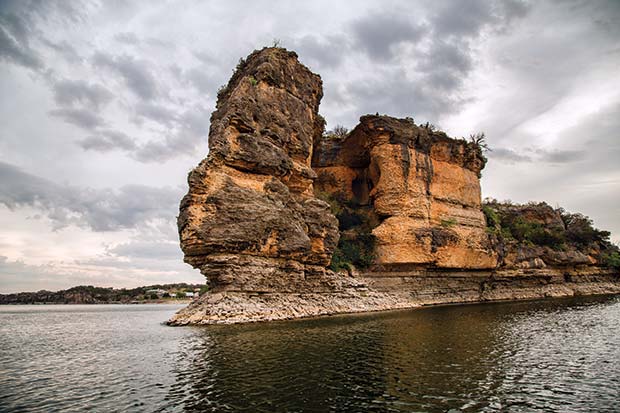 on the peninsula.
on the peninsula.
The dam that holds Possum Kingdom Lake, a reservoir on the Brazos River, was the launch spot for the late Texas author John Graves when he took the canoe trip that would become the basis of his 1960 book Goodbye to a River, a classic work of Texas naturalism and history. In June 2014 and May 2015, when the Red Bull Cliff Diving World Series arrived at the lake, the extreme divers added a new chapter to the Possum Kingdom story as they leapt from the 100-foot-high Hell’s Gate formation, drawing gasps and cheers from a crowd gathered in a flotilla of boats and floats. (The cliff diving series is expected to return in 2016.)
As the thousands of fun-seekers from the Dallas-Fort Worth area who visit “PK” already know, this 20,000-acre lake is a mecca of water recreation for everyone from nature-lovers to daredevils. Located about 90 minutes northwest of Fort Worth, Possum Kingdom is a bright-blue beacon for landlocked beachgoers, bass masters, water-skiers, and bird watchers. The nearby woodlands are recovering from the wildfires that struck in 2011, and spring rains have nearly filled the lake after years of low levels. Conditions are ripe to explore the 16 miles of Brazos River Authority hike-and-bike trails around the shore. The trail network also features campgrounds and swimming holes, while shutterbugs will want a camera to capture views from scenic lookouts.
Nestled in the hills of Palo Pinto County, Possum Kingdom State Park offers swimming, hiking, biking, and canoe rentals, as well as campsites and air-conditioned cabins. If all that activity leaves you in need of more luxury, The Inn at The Harbor offers an upscale alternative.
Even if you don’t have time to explore the John Graves Scenic Riverway below Morris Sheppard Dam, we’re betting you will have a tough time saying farewell to Possum Kingdom.
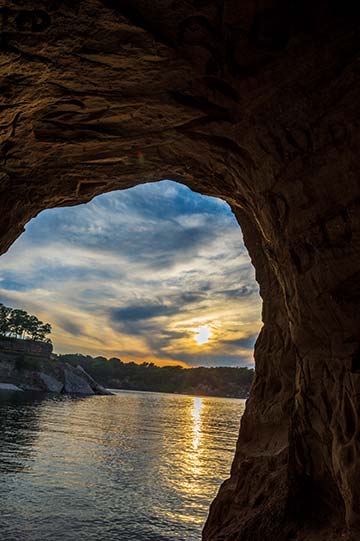 12. Lake Texoma: Texomaland
12. Lake Texoma: Texomaland
See www.lake texomaonline.com for restaurant suggestions.
Constructed in 1944 by the Army Corps of Engineers on the Texas-Oklahoma border, Lake Texoma ranks as the 12th largest lake in the United States, and provides a getaway for 6 million travelers a year. Despite the fact that two-thirds of the 75,000-acre reservoir is in Oklahoma, the majority of visitors make the short run from the Dallas-Fort Worth metroplex about an hour to the south.
For newcomers to Texomaland, as it’s sometimes called, a good first stop is Eisenhower State Park near the town of Denison. Named for the five-star general and 34th President of the United States, who was born in Denison, the state park opened to the public in 1958. The park has hiking and biking trails, as well as a three-mile ATV course that winds through a nearby forest (permit required), but water-based recreation is the name of the game. Inside the park, the Eisenhower Yacht Club Marina offers full services to private boat-owners and also has a public rental fleet of stand-up paddle boards, kayaks, and pontoon boats. You’ll also find fishing supplies, night crawlers, and snacks.
“People mostly come in for fuel and ice cream,” says longtime yacht club employee Dakota Brooks, who says their busiest time of year runs from Memorial Day through Labor Day. People also fish for crappie and striped bass—Texoma is the rare large lake with a spawning population of stripers—as well as catfish. In 2004, a state-record 121.5-pound blue catfish was caught on the lake near Hagerman National Wildlife Refuge. With activities such as hiking and wildlife-viewing, the refuge offers landlubbers plenty of choices. But to paraphrase Ike: Water is the treasure of these lands—“our most valuable, most prized, most critical resource.”
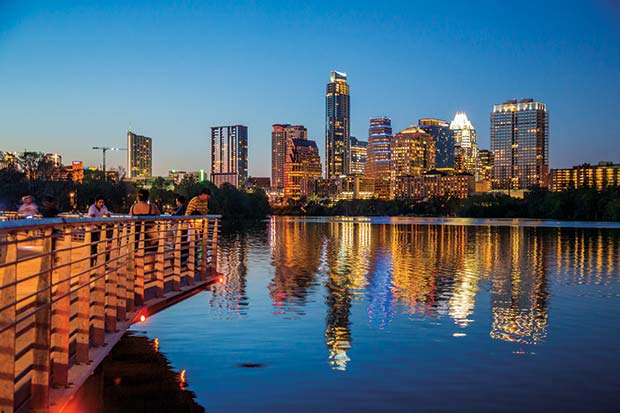 restaurant offers patio dining with views of the lake. A daily happy hour features half-price wines.
restaurant offers patio dining with views of the lake. A daily happy hour features half-price wines.
Lady Bird Lake in Austin—the Colorado River impoundment formerly known as Town Lake—has long been a treasured recreational resource for the Texas capital. Five miles long and now outlined with a circle of trails extending 10 miles, the urban oasis draws more than a million visitors a year. Regulars include runners, cyclists, and anglers pursuing everything from red-eared sunfish on a fly to giant carp with specialized bait. In 2014, a New Braunfels fisherman caught a 13-pound largemouth bass in these waters, a lake record.
Paddling vies for popularity on Lady Bird Lake, which has eight public ac-cess points for boaters and is home to an 11-mile Texas Parks and Wildlife paddling trail. Public rowing docks (www.rowingdock.com and www.texasrowingcenter.com) offer canoe and kayak rentals. Standup paddling (SUP) is so widespread in Austin that, according to Outside magazine, the city recently claimed the title of “SUP Capital of the World.” Outfitters such as Austin Paddle Sports promote night trips, weekly SUP’n’sip happy hours, and waterbound “board meetings.”
Although swimming in Lady Bird Lake itself is forbidden, iconic Barton Springs Pool, located in 358-acre Zilker Park, which also adjoins Lady Bird Lake, is one of the most famous swimming holes in the state. A constant average temperature of 68-70 degrees makes the 1,000-foot-long pool a magnet for swimmers, especially in the heat of summer. It’s all part of a legacy that surely would have pleased the Texas-born First Lady.









